“Film Noir was when tough guys were really tough and almost every gal was a Femme Fatale.” ~ Unknown
/ fem fəˈtal, fem fəˈtäl / noun
An attractive and seductive woman, especially one who will ultimately bring disaster to a man who becomes involved with her.
But don’t be fooled! Whether you know it or not, Shelley Winters portrayed the Femme Fatale — and/or “Bad Girl” — in a good share of her Film Noir productions. And that is… When Shelley Winters Did Gangsta!
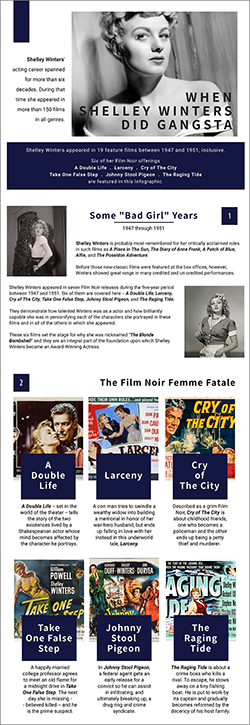
(opens in a new window)
If you research her filmography, you will find a remarkable library of fine films from the Noir era in which Winters more than carries her own. There is no doubt that most film buffs these days, this writer included, remember the thespian in her later dramatic and comedic roles when she was a middle-aged or older actor. But Winters began her career as a teenager during the “Golden Age” of Hollywood and she went on to work for more than 60 years in both film and television.
Shelley Winters’ library of work from those early years stands up against any of her contemporaries and it continues to captivate and entertain. She was an awesomely gifted actor whose work speaks to and for her devotion to her career and her craft.
She worked prolifically during her first decade “in the business,” so to speak, the years in which the six Film Noir selections covered in this article — A Double Life, Larceny, Cry of The City, Take One False Step, Johnny Stool Pigeon, and The Raging Tide — were produced. Today we don’t hear much about them, especially since the highly acclaimed A Place in The Sun was also released during the same window-in-time as these specific films.
In this five year window from 1947 through 1951, Winters appeared in close to 20 films. Most of them were of the Film Noir genre, but there also are a couple of Westerns, some classic Dramas, and at least one RomCom (Romantic Comedy) in the bunch. All of them collectively serve to demonstrate her range and talent as an actor.
A rich library of Shelley Winters films is left for all of us to enjoy. The films included here are entertaining and they captivated us as we watched them for the very first time.
We hope that you are inspired by this Review, with its Imagery and related Infographic (at right).
Please be encouraged to watch these early Film Noir films that featured — and in some cases also starred — Shelley Winters!
A DOUBLE LIFE (1947)
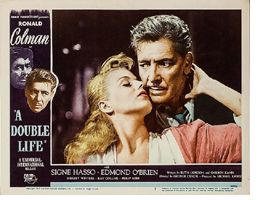 A Double Life
A Double Life is not your everyday run-of-the-mill Film Noir selection. In fact, it has been considered as not being Film Noir cinema at all by some film critics.
In any case, it was a big hit with both audience and critics alike, winning Oscars for Best Actor in a Leading Role (for Ronald Colman, who also won a Golden Globe for “Best Actor” in this dramatic role) and Best Music Score for a Drama or Comedy (Miklos Rozsa). It also received Oscar nominations for Best Director (George Cukor) and Best Writing of an Original Screenplay (Garson Kanin and Ruth Gordon).
The film tells the story of actor, Anthony “Tony” John (Colman), who finds it impossible to separate himself from his roles.
Shelley Winters has a small, but pivotal, role in A Double Life, and it is one of her very early appearances, if not first, as credited actor “Shelley Winters.” (An interesting note here is that hers is a larger role than that of Ray Collins, a more seasoned actor now mostly remembered as Lieutenant Arthur Tragg on the television series, Perry Mason.)
Winters portrays Pat Kroll, an attractive, light-hearted, and way-too-friendly masseuse who moonlights as a waitress at the Venezia Cafe. Kroll’s chance meeting with John at the restaurant leads to a tryst between them at her apartment later that evening.
During what turns out to be John’s frenetic soliloquy about who he is, she exclaims, “What am I mixed up with here, some kind of a nut?!” Needless to say (or write) that this was THE warning that something sinister was yet to come.
Kroll eventually meets her demise at the hands of this unstable actor. His mental state had unfortunately descended into the dark depths of his latest role as the lead in Shakespeare’s “Othello,” who, as we all know, strangled his wife during the “Kiss of Death.”
Never one to undermine a good ending by giving it away, let’s just suffice it to mention that the film culminates in a surprise and unexpected occurrence that resolves the crime as the curtain comes down on the theater production.
Winters portrays “buxom, hard and tough, soft and sweet” successfully, as described by another character in the film. And, impressively, she appears on screen for no more than a total of about 10 minutes, but her three pivotal scenes stitch the parts of the entire plot together and they help to make A Double Life work.
It had taken Shelley Winters only five years to achieve this milestone performance, which ultimately is considered her breakout role!
Here’s the full movie:
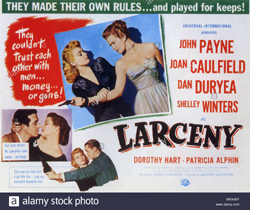 There are lots of really evil people in this world! Many are unrepentant types who will lie to you with a straight face while appealing to your better sensibilities. They will take advantage of your good graces and goodwill. And if given the chance, they will take you for all you’re worth — and even more!
There are lots of really evil people in this world! Many are unrepentant types who will lie to you with a straight face while appealing to your better sensibilities. They will take advantage of your good graces and goodwill. And if given the chance, they will take you for all you’re worth — and even more!
That is the basic premise of the appropriately titled Larceny.
This Film Noir tells of a gang of grifters and the plan to swindle a widow via a war memorial con, but their lead guy falls in love with her.
It stars John Payne as Rick the manipulative lead con man, Joan Caulfield as the well-loved and highly-respected wealthy widow, Dan Duryea as the gang’s boss, and Shelley Winters as the gangster’s moll whose also having an affair with the lead con man.
Larceny opens to happy, light, upbeat, almost cheerful music that, in spite of its title, gives no clue of the sinister plot that is to come. The lead characters are about to pull off a con on some upstanding citizens who invested in their phony Miami Beach yacht club development. But, alas, everything falls apart when the mark who they enlisted to raise funds from local investors reveals the evidence he obtained while researching these guys who proposed the project. Obviously busted, the gang decides to relocate to Southern California for their next job.
Shelley Winters’ character, Tory, appears in the next scene and it is clear very quickly that she’s a bad girl who lives on the edge. As the gang discusses their next job in L.A., Tory is introduced to us by the boss who orders her to “fix the boys a drink.” Before you’ve watched 15 minutes of this film, she’s been roughed up and knocked around plenty by at least one of her boyfriends.
Tory’s character is now established as the bad girl on a range of female types in this film. The opposite end and flip side of the coin is represented by the “Goody Two-Shoe” widow, Deb, the good girl (Caufield). If these two are not contrast enough, two additional women — a waitress who will remain nameless and the secretary Madeline — help to show the character continuum on the scale from “Good Girl” to “Bad Girl.”
Now the war memorial con becomes the main focus of Larceny, but the story also depends on the sub-plot of Tory versus Deb, with waitress and secretary as foils that exist somewhere in the middle. The bad girl and good girl roles and their perspectives are demonstrated in the following table, which includes some of their spoken lines or lines spoken about them by other characters in the film.
| Tory (Gangster Moll) | Deb (Goody Two-Shoe) | ||
| “Funny, I thought that all women are the root of all evil.” | “Deb’s a wonderful gal.” …Hotel Clerk | ||
| “You’re not very bright.” | “She’ll want to see any friend of Jim.” …Hotel Clerk | ||
| “You kiss like you’re paying off an election bet.” | “That’s a beautiful thought, Rick.” | ||
| “Rick, what would you do with a girl who behaved herself?” | “Oh, it’s been a wonderful day.” | ||
| “Did I tell you about the jealous wife who cut out the girlfriend’s heart and served it to her husband?” …Tory to waitress | “You’re nice, Rick.” | ||
| “I’m just an outraged woman who will cut your throat if you talk to my husband again.” …Tory to waitress | “I want to build it all by myself, with my own money.” | ||
| “She’s business. I’m pleasure.” | “Yes, she can be that niave.” …Rick to Tory |
As the story unfolds, it is clear that Rick is falling in love with Deb. And before the con job is complete, the bad girl has confronted the good girl — or is it the other way around? Just as you think that love is about to win out over everything else, the story comes to a very quick, almost sudden, end, which is quite a surprising.
There was no surprise, however, what ended up happening to these Film Noir women. The waitress was left standing behind the cafe counter, secretary was left waiting at the airport, and it didn’t end pretty for either the good girl or bad girl!
Here are some clips from the film:
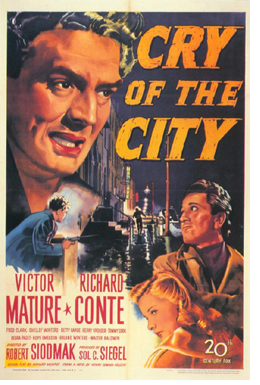 Cry of The City
Cry of The City is highly praised by contemporary critics and considered to be an important example of the Film Noir genre. It stars Victor Mature, Richard Conte, Fred Clark, and Shelley Winters.
The film is not rated, but has a title screen that warns, “Not suitable for children.” Perhaps this is because of its many “seedy” characters — at least that is how they would have been considered during the time of this film’s release.
Leonard Maltin described the film as a rehash of Manhattan Melodrama, which was about childhood pals, one who becomes a cop and the other a criminal. (Manhattan Melodrama is the last movie that mobster John Dillinger saw in a public movie theater, after which he was shot to death by federal agents.)
Cry of The City opens with the lead character, a petty thief and cop killer Martin Rome (Conte) in a prison hospital recovering from the gun shot wound he sustained during a shoot out with the police.
As in A Double Life, Shelley Winters has a small role that bridges together the two halves of the film. Here she portrays Brenda, Rome’s old girlfriend.
Winters makes her appearance halfway through the film as Rome has escaped from the hospital. He enlists Brenda’s help to find the woman who he suspects as the perpetrator of a jewel heist for which he is being falsely accused.
Shelley Winters is on screen for less than 10 minutes, but she gives a memorable dramatic, almost comedic cameo performance. Her character stands out as she quickly strolls around the streets in her fake leopard coat. One can only smile after hearing her tell a drunk in a cocktail bar, “Junior, why don’t you be a nice boy and beat it,” encouraging him to leave her alone when he tries to pick her up.
Listen out for Cry of The City‘s familiar theme music. It is a melody made famous by many gangster movies of the era. This iconic score is Alfred Newman’s “Street Scene,” which debuted in the 1931 film of the same name.
Here’s the theatrical trailer for the film — and you might be able to see the full film on YouTube:
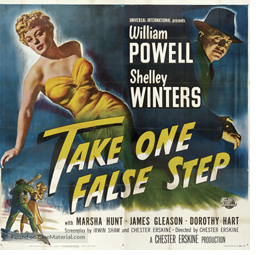 Shelley Winters appears to have arrived as a major player in Film Noir circles with Take One False Step
Shelley Winters appears to have arrived as a major player in Film Noir circles with Take One False Step.
Unlike most of her previous movies in which she played small but sometimes pivotal roles, Winters is seen for a good percentage of this film’s runtime. Also, her name appears above the title along with William Powell’s on posters and can be seen on the film’s title screen.
Winters had graduated from the “bridge-type” roles that she played in A Double Life and Cry of The City. Now she not only plays a major character, but appears in the very first scene. Winters’ character is an almost bookend role and she is central to the plot of the movie.
During the opening titles of Take One False Step, various precarious and potentially dangerous situations that imply the film’s title are shown. Things like:
• Teetering on a tightrope;
• Stepping in front of a moving car;
• Getting into stranger’s car;
• Strolling on a slippery floor;
• Dancing with a clumsy partner;
• Walking onto icy steps;
• Stepping on a bar of soap while getting out of the tub; and
• Exiting a car without seeing the open manhole.
Take One False Step is about a celebrated and happily married college professor, Andrew Gentling (Powell), who has a drink and midnight drive with an old girlfriend, Catherine Sykes (Winters), herself now married. The next day she has disappeared — suspected by police and everyone else of having been murdered — and he is the prime suspect. He decides to elude the authorities and try to solve the crime by himself.
Eventually there are newspaper headlines like “Housewife Feared Murdered” and “Mystery Man Sought” and “New Clue in Case of Missing Blonde.” The story proceeds as Gentling follows the unfolding evidence toward the solution of the crime.
Without giving away any of the film’s suspense, let’s just offer up here that Shelley Winters is delightful in this film. She effectively portrays her role and helps to establish the plot at the beginning, then gives a devilish performance that helps to resolve the storyline during a highly-dramatic ending. Indeed, Shelley Winters gave one of her very best performances to date in this film!
Take One False Step was not well received by critics at the time of its release, with much criticism of William Powell, who sometimes played Professor Gentling like Nick Charles in the Thin Man films. However, critics liked the performance given by Shelley Winters. About her, New York Times film critic stated in his review that “…a little more of Miss Winters — as an active participant, that is — might have rendered a rather drab picture more decorative, at least.”
Does this mean that Powell was miscast in Take One False Step or that more screen time for Winters might have made for better, more interesting Film Noir cinema? We will never know how it might have been different, but the film represents an important step, and not a False Step — pun intended — in Shelley Winters’ career.
Here’s the full movie:
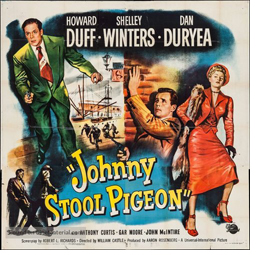 The very first words on the title screen of this Film Noir’s official trailer is: “This Really Happened!”
The very first words on the title screen of this Film Noir’s official trailer is: “This Really Happened!”
Johnny Stool Pigeon has a familiar gangster storyline, evidenced by Leonard Maltin’s description as “Standard drama of convict being sprung from prison so he can lead federal agents to former gang members.” And the Noir City 7 film festival program guide states that this film is one of the first Hollywood films to focus on the drug smuggling trade.
The film is about U.S. Treasury agent, Georgia Morton (Howard Duff), who persuades convicted criminal, Johnny Evans (Dan Duryea), to help him destroy a drug smuggling ring in exchange for early parole.
Shelley Winters is the only woman in this film’s credited cast and once again portrays the gang leader’s moll, which makes for a familiar reunion of Winters and Duryea as a crime-living couple. This time, however, both characters decide to reform themselves and leave their errant lifestyles behind before the story reaches its conclusion.
Johnny Stool Pigeon was neither saluted nor panned by critics when it was released in 1949. New York Times film critic stated, “Shelley Winters gives a credible performance as the blonde moll who also gives the law a much-needed assist.”
This is a hard-to-find film and one that we were not able to view. It remains on our want list and watch list.
If you are fortunate enough to see this film, look for a young Tony Curtis in his second credited role, here as “Anthony Curtis.” (Also, an interesting side note here is that Winters appears with Curtis again in the next film in which she appears, the 1950 western, Winchester ’73.)
Check out these Johnny Stool Pigeon snippets:
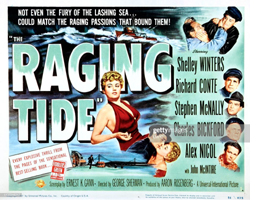 The Raging Tide
The Raging Tide was the 33rd film of Shelley Winters’ less-than-20-year professional career and at long last she had finally achieved top billing!
This film was released only two years after Johnny Stool Pigeon and during that time, Winters acted in six films that demonstrated her range as a actor. These included one Drama (A Place in The Sun), one Film Noir (He Ran All The Way), one Comedy (Behave Yourself), and three Westerns (Winchester ’73, South Sea Sinner, and Frenchie).
The Raging Tide was Shelley Winters return to Film Noir. The demonstration of her diversity as an actor during the past two years earned her the summit of her name being mentioned first on title screen and marketing collateral for this film. It was one of the rewards that she finally enjoyed over all other actors in this production.
This was Winters’ second film working with George Sherman, who had directed her in Larceny. She also is reunited with Richard Conte, who appeared with her in Cry of The City.
The film tells the story of crime boss Bruno Felkin (Conte) who is on the run after he kills a rival. He tries to arrange an alibi with his girlfriend, Connie Thatcher (Winters). Unfortunately for Felkin, Thatcher is no where to be found, so he has to hide out on a tiny fishing boat owned by some good folks. During the course of the story’s unfolding …Yada Yada Yada… then gradually over time, the decency of the host family rubs off on the couple and both Felkin and Thatcher become reformed characters.
Roger Ebert described Film Noir as “A movie which at no time misleads you into thinking there is going to be a happy ending.”
The Raging Tide is truly considered Film Noir, but is this a story with a happy ending? One wonders how it ends because this film is another “Hard-to-Finder” that was impossible to come across before this review, but we do know that there is a storm at sea. Hmmmmmm…
Here are the opening titles and some of the beginning scenes of The Raging Tide:
Shelley Winters went on to work for almost 50 years after appearing in A Double Life, Larceny, Cry of The City, Take One False Step, Johnny Stool Pigeon, and The Raging Tide.
Her determination and talent as an actor are evident in the six films presented here, as well as, in each of the others in her vast library of films in all genres left for us to enjoy. They are everlasting — and she will continue to thrill and entertain us forever!
 This article is our entry in the
This article is our entry in the
“The Shelley Winters Blogathon”
hosted by
and
October 1–3, 2019
Visit The Shelley Winters Blogathon to learn more about the great Shelley Winters!






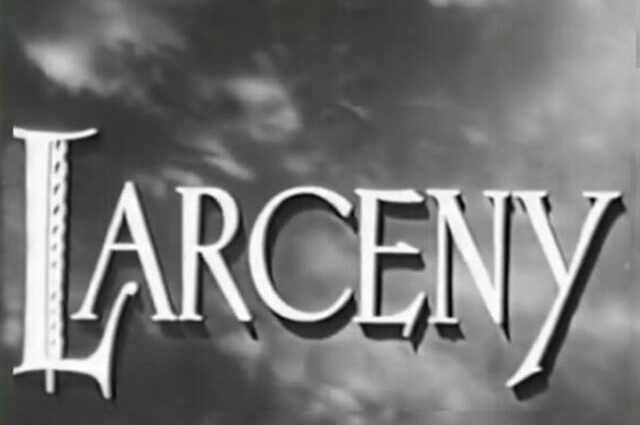







Nice roundup on one of Shelley’s best genres, noir and crime drama. She really was blessed to reinvent herself many times, expanding her repertoire and mastery as well as her waistline! The glamor gal and gun moll gave way to tragedienne, comedienne, character actor and grande dame. Thanks for joining the blogathon!
Yes, Shelley Winters was very gifted. I hope you enjoy her Film Noir cinema.
Thanks so much for this wonderful contribution for the blogathon, I adored the reviews and that you added some clips too! So many movies now added to the to watch list now. I’ve also got a blogathon coming up in November for the US Marines would be lovely if you can enter. Thanks from Gill at Realweegiemidget Reviews
I thoroughly enjoyed being a part of The Shelley Winters Blogathon. Thanks for hosting it!